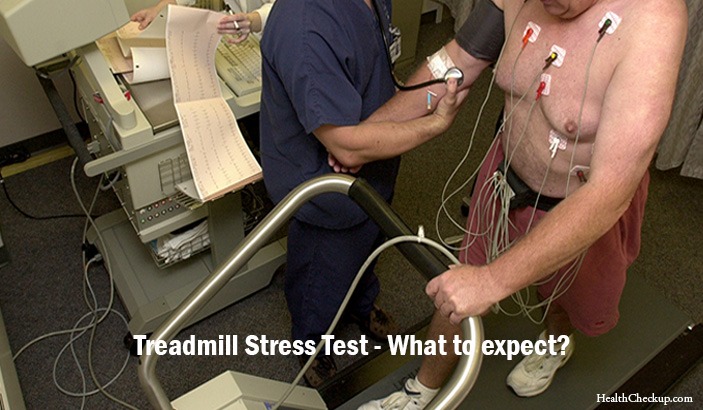People who are suspected of having a cardiac problem are advised to undergo a Treadmill Stress Test. While an ECG or Electrocardiogram gives a fair indication of the condition of one’s heart while the person is in a lying position, the best way to determine if the person has a heart disease is to get an exercise stress test done.
What is a Treadmill Stress Test?
A stress test, also called an exercise stress test, collects information about the working of your heart during physical activity. As exercise or physical activity makes your heart pump harder and faster than normal, the Treadmill Stress test can reveal problems in your heart that might not be noticeable. The Treadmill Stress Test involves walking on a treadmill while your heart rhythm, blood pressure, and breathing are monitored.
The stress test is an assessment done in two parts. In a very controlled situation, the heart is stress tested using either an exercise on a treadmill or a chemical injection, depending on the condition of the person getting the test. In most facilities, a treadmill is the most commonly used exercise equipment; others may use a stationary bicycle. The heart rate, rhythm, and blood pressure are continuously monitored throughout the duration of the test.
Why is a Treadmill Stress Test Done?
The Treadmill Stress Test can be ordered by your doctor in the following conditions:
- The doctor may recommend a stress test if it is suspected that you have a coronary artery disease, or an irregular heart rhythm (arrhythmia).
- The doctor could also ask for this test if you are suspected of a coronary artery disease, which develops as a result of plaque formation or cholesterol.
- The test may also be recommended to diagnose heart rhythm complaints (arrhythmias). This may be due to improper functioning of the electrical impulses that coordinate the heart rhythms.
- The test may also be recommended to patients who have already been diagnosed with a heart condition to ascertain the efficacy of the treatment.
How is the Treadmill Stress Test done?
During the Treadmill Stress Test, a technician attaches patches called electrodes on your chest, legs, and arms. These electrodes, which are connected by wires to an electrocardiogram record the heart’s electric signals. Your blood pressure is constantly monitored throughout the test. You may be asked to breathe into a tube during the test to analyze the rate of breathing during the exercise.
You are then asked to walk on the treadmill, and gradually the speed and the incline of the treadmill is increased. You are advised not to hold on to the railing of the treadmill tightly or else you may generate an erroneous reading.
The test takes place in two stages – in the first stage, the readings of the heart are taken when it is in the normal phase; and in the second stage, the readings of the heart are taken when it is subjected to stress. Pictures are taken of the heart in the first stage and the second stage. The pictures of the first stage and the second stage are compared and conclusions drawn.
Remember, that you should stop the test any time you are uncomfortable and cannot continue with the test.
What to Expect During a Treadmill Stress Test?
- Placing of electrodes: The nurse or technician will place electrodes on your chest, legs, or arms. To ensure that the electrodes adhere firmly to the skin, the hair from these areas are shaved off.
- Connecting of electrodes: The electrodes are then connected to an ECG – Electrocardiogram machine, which records the various activities of your heart such as electrical signals, timing of your heartbeats, and the rhythm of your heartbeats.
- Monitoring Blood Pressure: A blood pressure cuff is placed on your arm and your blood pressure is constantly monitored.
You will be asked to continue exercising until your heart rate has reached a set target or until you develop symptoms that prevents you from continuing.
These Symptoms May Include:
- Moderate to severe chest pain
- Severe shortness of breath
- Abnormally high or low blood pressure
- Abnormal heart rhythm
- Dizziness
- Certain changes in your electrocardiogram
What is the Duration of a Treadmill Stress Test?
Stage one of the stress test may take about 10-15 minutes, and Stage two of the test may take another 15-20 minutes. The overall test may take approximately 45 minutes.
How Do You Prepare for the Treadmill Stress Test?
Before you undertake the test, the doctor will ask you about your medical history and the quantum of physical exercise that you normally undertake everyday to ascertain the amount of exercise that would be suitable to you during the Treadmill Stress Test.
The doctor would advise you not to eat, drink, or smoke for two at least hours before the Treadmill stress test. Ask your doctor if you have to avoid your medications as they may interfere with the stress test.
People who suffer from asthma or other breathing problems are advised to carry their inhalers wih them, if they are using one, to the test. You should tell the doctor or technician about your medical condition.
Ensure that you wear comfortable clothes to the test. You can go back to your normal activities after the test is over.
Medically Reviewed By









